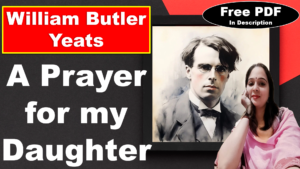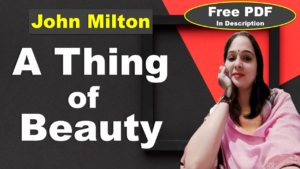Sivajee by Shoshee Chunder Dutt | Sivajee Poem | Shoshee Chunder Dutt | Explanation | Summary | Key Points | Word Meaning | Critical Appreciation | Questions Answers | Free PDF Download – Easy Literary Lessons
Sivajee
(Shoshee Chunder Dutt)
AURUNGZEB’S RECEPTION OF THE MAHRATTA LEADER.
Stanza 1
They led him to the stately hall,
Before the royal throne.
Where, towering in the pomp of power.
The tyrant sat alone;
And knights and nobles stood around.
Elate with haughty pride,
And slaves, in gorgeous tinsel dress’d,
Awaited by their side.
Stanza 2
He knelt before the tyrant’s throne,
But caught no courtly smile ;
The monarch looked with eye of scorn —
Then darkly gazed awhile ;
And minions proud, whose hearts had quail’d
When told his name of fear,
Now mock the valiant Sivajee
With cold respect and sneer.
Stanza 3
He could not bear their servile scorn —
The scorn of vassals low.
The passions of his stubborn heart
Were gathering on his brow ;
His bosom, plough with manly scars,
The records of his fame,
Now heaved with all a warrior’s wrath :
He was not born to shame.
Stanza 4
A fearful light shone in his eyes ;
Its meaning who could tell ?
And shook his frame, and from his lips
Some harsh expressions fell :
He stepped aside, his passions dark
Unable to control,
And struggled still, but yet in vain,
To curb his lofty soul.
Stanza 5
Overpower’d he sunk upon the ground,
But straight arose again :
This insult, tyrant, thou shalt rue —
He never frowns in vain.
With bloody purpose in his heart
He stood aloof — alone,
But sheathed still the avenging blade
Was sleeping in his zone.
Stanza 6
In dudgeon high lie left the Court,
Nor ask’d the king’s command;
But found himself deceived, betray’d,
A captive in the land.
But who can cross the fox’s wile?
Control the eagle free?
The royal guards are shrewd and true,
But where is Sivajee ?
Stanza 7
The bird has flown ; no stubborn cage
Its wily heart could tame ;
For deadlier works of death prepare —
He comes with sword and flame!
Ye ply to trap with subtle words;
That feeble art is vain;
The trusting bird, when once deceived.
Will never trust again.
Stanza 8
No, ne’er again he’ll cross the hall
To cringe on servile knee,
But oft, through battle’s dusky smoke.
His blood-red sword ye’ll see;
At merry feast he may not join,
But through the war-clouds dun,
O’er gasping chiefs and soldiers slain,
He’ll lead the carnage on.
Stanza 9
The bravest hearts shall own with dread
The fury of his wrath.
And sights of woe alone shall mark
The dread avenger’s path ;
With horror mute the wife shall gaze
Upon her murder’d lord,
While yet shall glow, though wet and dim,
The unrelenting sword.
Stanza 10
On vengeance he will build his name,
Till rocks aloud resound
Tlie glory of his valiant arms,
And quakes the unconscious ground ;
Till e’en the scorner, from his throne,
Shall mark the kindling fire,
And wish that he had never stirr’d
That haughty soul’s dark ire.










